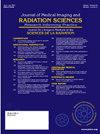A systematic review of the effectiveness of leaded glasses for ensuring safety among healthcare professionals in fluoroscopy
IF 1.3
Q3 RADIOLOGY, NUCLEAR MEDICINE & MEDICAL IMAGING
Journal of Medical Imaging and Radiation Sciences
Pub Date : 2025-01-16
DOI:10.1016/j.jmir.2024.101848
引用次数: 0
Abstract
Background
Currently, there is an increase in procedures across various clinical specialties involving the use of ionising radiation.
Objective
The primary objective of this systematic review is to analyse and compare the existing literature regarding the effectiveness of leaded glasses for healthcare professionals.
Methods
Comprehensive literature searches were conducted for relevant studies published between 2018 and 2023 using the Scopus, PubMed, and Web of Science databases according to preferred reporting items for systematic reviews and meta-analyses (PRISMA) methodology.
Results
After the complete text screening, 11 articles were deemed suitable for inclusion in the review. Leaded glasses significantly reduce eye radiation exposure, with studies showing shielding effects ranging from 10 % to 88,9 %, depending on the configuration and thickness of the glasses. For instance, lightweight glasses achieved a shielding effect of 61.4 %, while thicker lead equivalents (≥0.5 mm) offered up to ninefold dose reductions. Studies also noted the importance of lateral shielding and ergonomic designs for optimal protection. Leaded glasses significantly reduce eye lens doses but are most effective when combined with other protective measures. Factors such as head orientation, procedural complexity, and operator movement influence their performance. The findings underscore the need for standardised guidelines on protective eyewear use and further research under real-world clinical conditions.
Conclusion
It is essential to ensure the proper use of leaded glasses to minimize the risks of ionising radiation for healthcare professionals in fluoroscopy procedures.
含铅眼镜的有效性的系统评价,以确保安全的医护人员在透视。
背景:目前,在不同的临床专业中使用电离辐射的程序有所增加。目的:本系统综述的主要目的是分析和比较现有文献关于医疗保健专业人员使用含铅眼镜的有效性。方法:使用Scopus、PubMed和Web of Science数据库,根据系统评价和荟萃分析(PRISMA)方法的首选报告项目,对2018 - 2023年发表的相关研究进行综合文献检索。结果:经过完整的文本筛选,11篇文章被认为适合纳入本综述。含铅眼镜可显著降低眼睛的辐射暴露,研究表明,根据眼镜的配置和厚度,屏蔽效果在10%至88.9%之间。例如,轻质玻璃达到了61.4%的屏蔽效果,而较厚的铅当量(≥0.5 mm)提供了高达9倍的剂量减少。研究还指出了侧向屏蔽和人体工程学设计对最佳保护的重要性。含铅眼镜可显著减少镜片剂量,但与其他保护措施结合使用时效果最好。诸如头部方向、程序复杂性和操作员运动等因素影响其性能。研究结果强调,需要制定防护眼镜使用的标准化指南,并在实际临床条件下进行进一步研究。结论:应正确使用含铅玻璃,以降低医疗人员在透视过程中电离辐射的风险。
本文章由计算机程序翻译,如有差异,请以英文原文为准。
求助全文
约1分钟内获得全文
求助全文
来源期刊

Journal of Medical Imaging and Radiation Sciences
RADIOLOGY, NUCLEAR MEDICINE & MEDICAL IMAGING-
CiteScore
2.30
自引率
11.10%
发文量
231
审稿时长
53 days
期刊介绍:
Journal of Medical Imaging and Radiation Sciences is the official peer-reviewed journal of the Canadian Association of Medical Radiation Technologists. This journal is published four times a year and is circulated to approximately 11,000 medical radiation technologists, libraries and radiology departments throughout Canada, the United States and overseas. The Journal publishes articles on recent research, new technology and techniques, professional practices, technologists viewpoints as well as relevant book reviews.
 求助内容:
求助内容: 应助结果提醒方式:
应助结果提醒方式:


